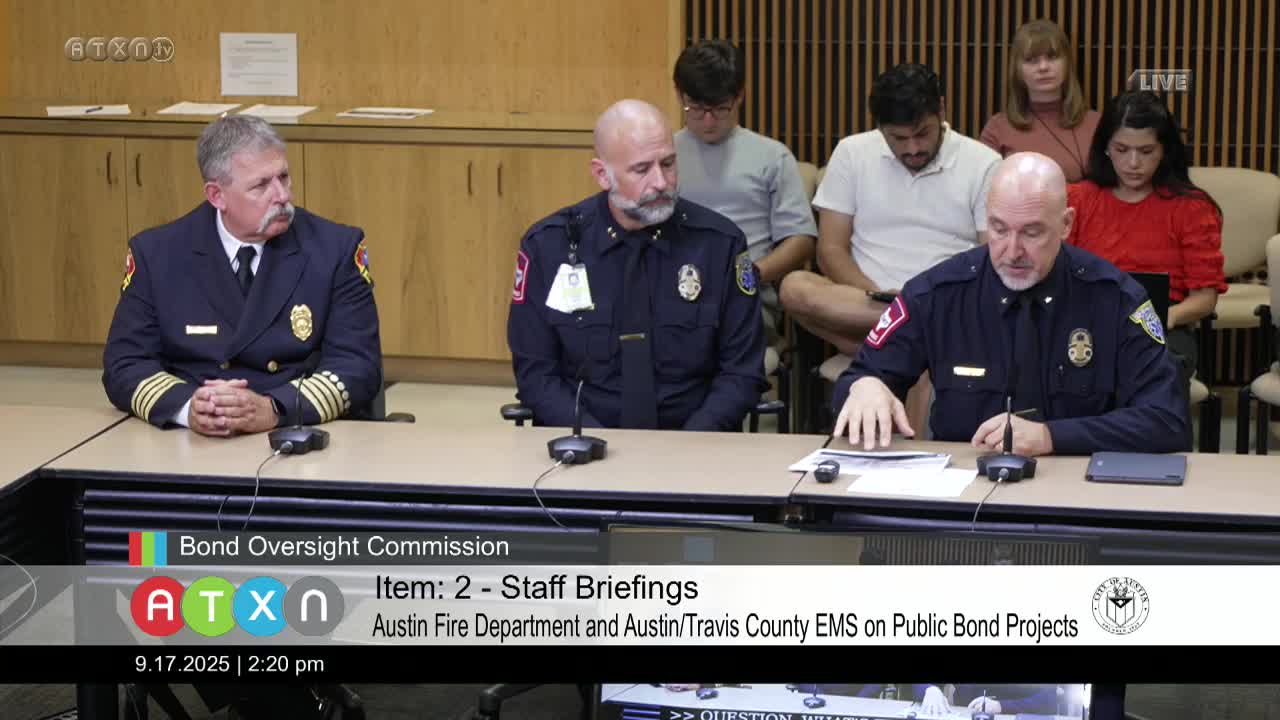Austin EMS Reports 18% Call Volume from Community Health Programs
September 17, 2025 | Austin, Travis County, Texas
This article was created by AI summarizing key points discussed. AI makes mistakes, so for full details and context, please refer to the video of the full meeting. Please report any errors so we can fix them. Report an error »

In the heart of Austin's city hall, members of the Bond Oversight Commission gathered to discuss the ongoing projects funded by the 2018 bond, focusing particularly on the fire department and emergency medical services (EMS). As the meeting unfolded, the urgency of finalizing capital delivery services became apparent, with officials noting that the last funds would be distributed once final permits were received.
The commission reported that nearly all of the original funding—97 to 98 percent—allocated for the fire department has been spent, leaving approximately $200,000 for deferred maintenance on a station. This financial update highlighted the careful management of resources as the city navigates the complexities of public safety funding.
A significant portion of the discussion centered on the EMS Station 5, which has been pivotal in addressing the healthcare needs of the community, particularly among those who rely on emergency services as their primary healthcare option. Steven White from Austin-Travis County EMS shared that the station handles between 16 to 18 percent of the total call volume, translating to around 4,000 to 4,500 calls each month. This statistic underscores the critical role of EMS in the community, especially in areas with a transient population.
White elaborated on the innovative approach taken by the EMS, which includes the deployment of physician assistants and community health paramedics. These professionals are trained to respond to both medical emergencies and mental health crises, providing immediate care and facilitating access to the broader healthcare system. This dual approach not only addresses urgent health needs but also aims to break the cycle of individuals using 911 as their only means of healthcare access.
The meeting also touched on the importance of triage, with discussions on how calls are assessed upon receipt and how on-scene crews can request additional medical support when necessary. This proactive strategy is designed to ensure that patients receive appropriate care without overwhelming emergency rooms.
As the meeting concluded, the commissioners acknowledged the need for future proposals related to the new fire EMS program, hinting at ongoing discussions about funding and resource allocation. The insights shared during this session reflect a commitment to enhancing public safety and health services in Austin, ensuring that the community's needs are met with efficiency and compassion.
The commission reported that nearly all of the original funding—97 to 98 percent—allocated for the fire department has been spent, leaving approximately $200,000 for deferred maintenance on a station. This financial update highlighted the careful management of resources as the city navigates the complexities of public safety funding.
A significant portion of the discussion centered on the EMS Station 5, which has been pivotal in addressing the healthcare needs of the community, particularly among those who rely on emergency services as their primary healthcare option. Steven White from Austin-Travis County EMS shared that the station handles between 16 to 18 percent of the total call volume, translating to around 4,000 to 4,500 calls each month. This statistic underscores the critical role of EMS in the community, especially in areas with a transient population.
White elaborated on the innovative approach taken by the EMS, which includes the deployment of physician assistants and community health paramedics. These professionals are trained to respond to both medical emergencies and mental health crises, providing immediate care and facilitating access to the broader healthcare system. This dual approach not only addresses urgent health needs but also aims to break the cycle of individuals using 911 as their only means of healthcare access.
The meeting also touched on the importance of triage, with discussions on how calls are assessed upon receipt and how on-scene crews can request additional medical support when necessary. This proactive strategy is designed to ensure that patients receive appropriate care without overwhelming emergency rooms.
As the meeting concluded, the commissioners acknowledged the need for future proposals related to the new fire EMS program, hinting at ongoing discussions about funding and resource allocation. The insights shared during this session reflect a commitment to enhancing public safety and health services in Austin, ensuring that the community's needs are met with efficiency and compassion.
View full meeting
This article is based on a recent meeting—watch the full video and explore the complete transcript for deeper insights into the discussion.
View full meeting
